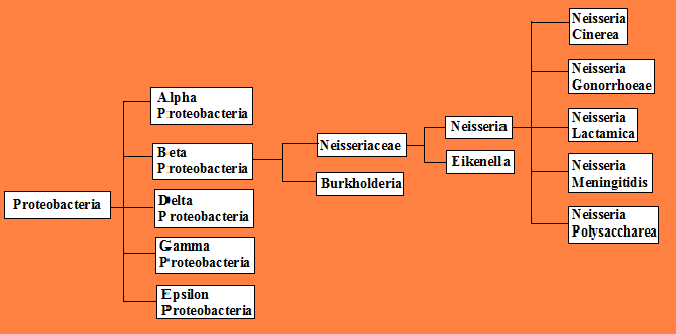Neisseria Meningitidis



 Classification
and Lineage
Classification
and Lineage
Classification:
Domain: Prokaryote
Kingdom: Bacteria
Phylum: Proteobacteria
Class: Betaproteobacteria
Order: Neisseriales
Family: Neisseriaceae
Genus: Neisseria
Species: Neisseria Meningitidis
Prokaryote: N. Meningitidis is classified among the prokaryotes because it lacks a nucleus and membrane bound organelles.
Bacteria: N. Meningitidis is a member of the kingdom bacteria because it is unicellular and small as most bacteria are. This kingdom encompasses a wide variety of organisms. Some of these organisms are pathogenic in humans like N. Meningitidis. An example of a somewhat more common pathogenic bacteria would be Bordetella pertussis which is responsible for Whooping Cough in humans. Some members of this group may be pathogenic in something other than humans as Pseudomonas syringae is a pathogen in plants. An example of a bacteria that is non pathogenic Deinococcus radiodurans because it does not cause any disease.
Proteobacteria: N. Meningitidis is classified as a proteobacteria because it is gram negative with an outer membrane of lipopolysaccharides and because many proteobacteria are pathogenic as is N. Meningitidis.
Neisseriales and Neisseriacaeae: N. Meningitidis is classified in this order and family because it is strictly aerobic, gram negative, and occurs in pairs (diplococci).
Neisseria: N. Meningitidis is part of this genus because all are gram negative, many are pathogenic and it is diplococci.
Lineage Key:

The genus Neisseria has many different members. The members listed above: N. Gonorrhoeae, N Cinerea, N. Lactamica, N. Meningitidis, and N. Polysaccharea are all strains that are non-pigmented and form translucent colonies. They all are also generally not saaccharolytic which means they are not capable of hydrolyzing or breaking down a sugar molecule.
Find out if you're going to die...go to N. Meningitidis Pathogenesis next!
Domain: Prokaryote
Kingdom: Bacteria
Phylum: Proteobacteria
Class: Betaproteobacteria
Order: Neisseriales
Family: Neisseriaceae
Genus: Neisseria
Species: Neisseria Meningitidis
Prokaryote: N. Meningitidis is classified among the prokaryotes because it lacks a nucleus and membrane bound organelles.
Bacteria: N. Meningitidis is a member of the kingdom bacteria because it is unicellular and small as most bacteria are. This kingdom encompasses a wide variety of organisms. Some of these organisms are pathogenic in humans like N. Meningitidis. An example of a somewhat more common pathogenic bacteria would be Bordetella pertussis which is responsible for Whooping Cough in humans. Some members of this group may be pathogenic in something other than humans as Pseudomonas syringae is a pathogen in plants. An example of a bacteria that is non pathogenic Deinococcus radiodurans because it does not cause any disease.
Proteobacteria: N. Meningitidis is classified as a proteobacteria because it is gram negative with an outer membrane of lipopolysaccharides and because many proteobacteria are pathogenic as is N. Meningitidis.
Neisseriales and Neisseriacaeae: N. Meningitidis is classified in this order and family because it is strictly aerobic, gram negative, and occurs in pairs (diplococci).
Neisseria: N. Meningitidis is part of this genus because all are gram negative, many are pathogenic and it is diplococci.
Lineage Key:

N. Meningitidis is a member of the Beta Proteobacteria. Other members of the Proteobacteria that have similar characteristics to the Beta Proteobacteria are the Alpha, Delta, Gamma, and Epsilon Proteobacteria. Beta and Gamma Proteobacteria both have members within their groups that are pathogens. Beta and Alpha Proteobacteria both have some phototrophic members. Beta and Delta Proteobacteria both have predominantly aerobic genera. Beta and Epsilon Proteobacteria both have pathogens within their groups that live specifically in humans.
The genus Neisseria has many different members. The members listed above: N. Gonorrhoeae, N Cinerea, N. Lactamica, N. Meningitidis, and N. Polysaccharea are all strains that are non-pigmented and form translucent colonies. They all are also generally not saaccharolytic which means they are not capable of hydrolyzing or breaking down a sugar molecule.
Find out if you're going to die...go to N. Meningitidis Pathogenesis next!





